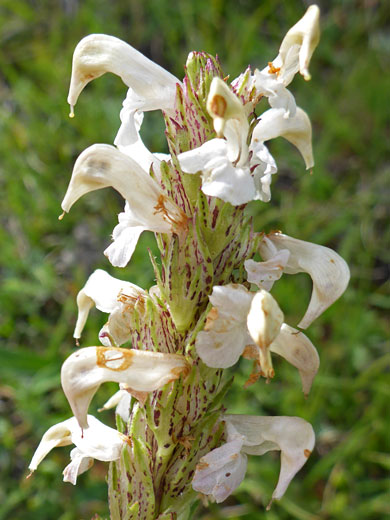Common name:
Parry's lousewort
Family:
Scientific name:
Pedicularis parryi
Main flower color:
Range:
The Four Corners states, and states to the north
Height:
From 4 to 24 inches
Habitat:
Mountain meadows, from 7,500 to 12,500 feet
Leaves:
Stalked, linear, up to 5 inches long, evenly pinnately lobed
Season:
June to August
Pedicularis parryi is found in the Rocky Mountains, along the southern edge of the Colorado Plateau in Arizona, and in mountainous areas of Utah. Plants produce a closely-spaced cluster of stems, with leaves mainly at the base. Stems and leaves are usually hairless. Leaves are narrow, and evenly divided into many small, toothed segments, at most 0.2 inches long. Leaf edges are often purple, though tips of the marginal teeth are white. Stems, bracts and calyces are usually flecked with purple blotches.
The inflorescence is a narrow spike, of white or purple flowers subtended by leafy, lobed bracts. Calyces are around 0.7 inches in length, divided into five narrow, almost linear lobes, with finely toothed margins, while the corolla is around twice as long; it has a pinched, downwards-curving upper lip, greenish-yellow towards the apex (for white-flowered plants), and a three-lobed lower lip.
There are three subspecies: ssp mogollonica, a taller plant (up to 2 feet) with larger and more numerous stem leaves, occurs in Arizona, Utah and New Mexico. The more widespread ssp parryi has fewer stem leaves and is shorter, around one foot, while ssp purpurea has purple flowers and is found in more northerly locations.
The inflorescence is a narrow spike, of white or purple flowers subtended by leafy, lobed bracts. Calyces are around 0.7 inches in length, divided into five narrow, almost linear lobes, with finely toothed margins, while the corolla is around twice as long; it has a pinched, downwards-curving upper lip, greenish-yellow towards the apex (for white-flowered plants), and a three-lobed lower lip.
There are three subspecies: ssp mogollonica, a taller plant (up to 2 feet) with larger and more numerous stem leaves, occurs in Arizona, Utah and New Mexico. The more widespread ssp parryi has fewer stem leaves and is shorter, around one foot, while ssp purpurea has purple flowers and is found in more northerly locations.
All Contents © Copyright The American Southwest | Comments and Questions | Contribute | Site Map







